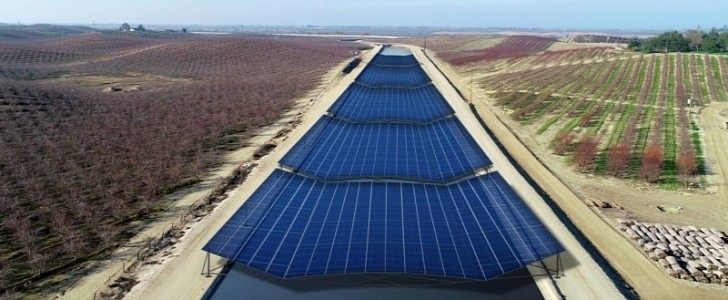The fall of 2022 brings along a first-of-its-kind project in the US. Turlock Irrigation District (TID) teamed up with the California Department of Water Resources, University of California Merced, and water and energy project developer Solar AquaGrid to install solar panel canopies over various sections of TID’s irrigation canals.
The private/public/academic collaboration goes by the name of “Project Nexus,” and will serve as proof of concept “to pilot and further study solar over canal design, deployment, and co-benefits on behalf of the State of California using TID infrastructure and electrical grid access.”
The main goal is simple: increase renewable power generation. Since California wants to achieve 50% clean energy production by 2025 and 60% by 2030, the project is both timely and promising. Given the state has around 4,000 miles (6,437 km) of water canals, it can put its resources to good use in a way that’s never been done before in the US.
What started it all was a 2021 study by the University of California Merced, pointing out the many benefits of covering the public water delivery system infrastructure in California with solar panels. Not only can this help generate more clean energy without “wasting” valuable land for solar farms but it also reduces water evaporation in canals and improves their water quality.
Moreover, it would save 63 billion gallons of water each year (enough to water 50,000 acres of farmland or solve the water needs of over 2 million residents), and produce 13 gigawatts of renewable power – about one-sixth of California’s current installed capacity.
With so many benefits, Project Nexus is a good way to test the concept on a smaller scale. Around 8,500 feet of solar panels will be deployed over three sections of TID’s canals starting this fall. Various types of panels will be used to see what would generate the best results. Besides that, energy storage solutions will also be explored.
If everything goes well, the entire project should be completed by the end of 2023. And who knows, besides households, maybe the full-scale project could have a positive impact on the EV charging infrastructure down the road.
The main goal is simple: increase renewable power generation. Since California wants to achieve 50% clean energy production by 2025 and 60% by 2030, the project is both timely and promising. Given the state has around 4,000 miles (6,437 km) of water canals, it can put its resources to good use in a way that’s never been done before in the US.
What started it all was a 2021 study by the University of California Merced, pointing out the many benefits of covering the public water delivery system infrastructure in California with solar panels. Not only can this help generate more clean energy without “wasting” valuable land for solar farms but it also reduces water evaporation in canals and improves their water quality.
Moreover, it would save 63 billion gallons of water each year (enough to water 50,000 acres of farmland or solve the water needs of over 2 million residents), and produce 13 gigawatts of renewable power – about one-sixth of California’s current installed capacity.
With so many benefits, Project Nexus is a good way to test the concept on a smaller scale. Around 8,500 feet of solar panels will be deployed over three sections of TID’s canals starting this fall. Various types of panels will be used to see what would generate the best results. Besides that, energy storage solutions will also be explored.
If everything goes well, the entire project should be completed by the end of 2023. And who knows, besides households, maybe the full-scale project could have a positive impact on the EV charging infrastructure down the road.






